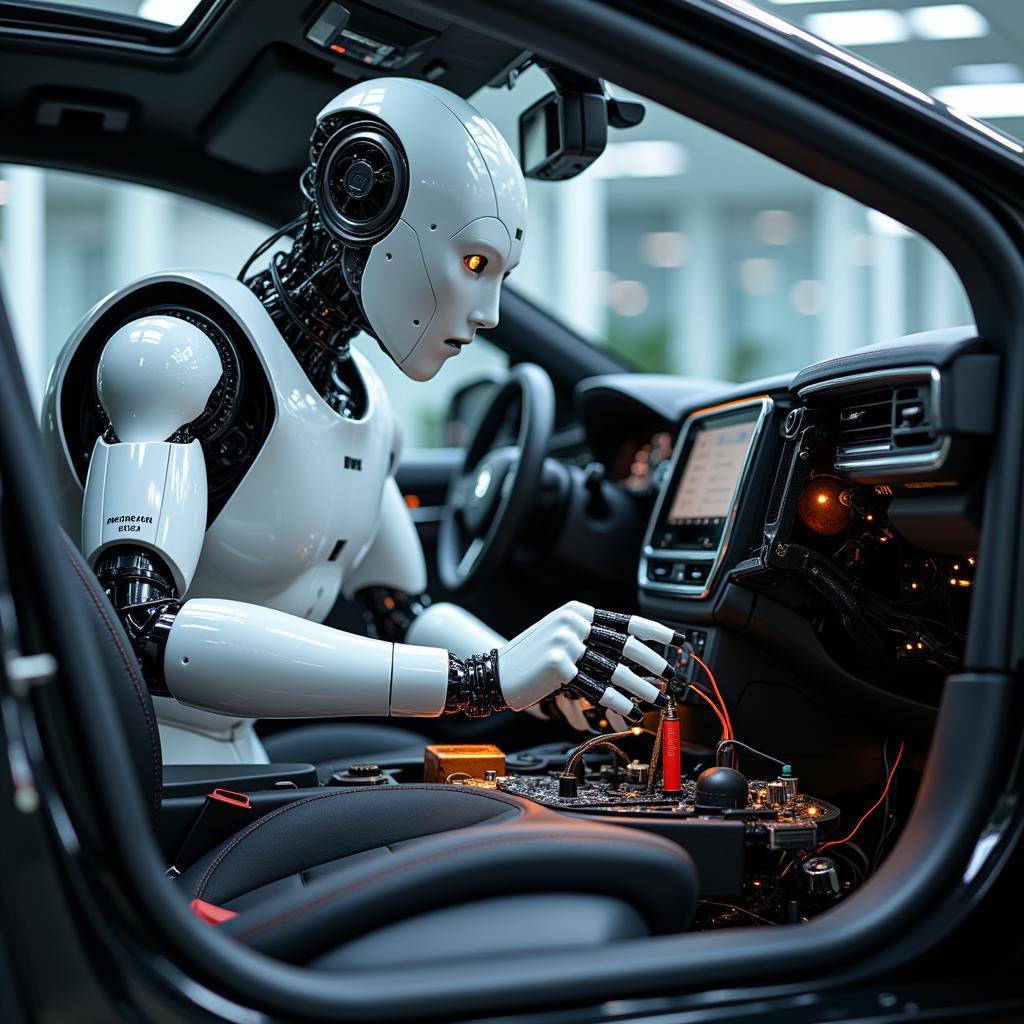Can Robots Fix Cars? The automotive industry is rapidly evolving, and the use of robots in car repair is becoming increasingly common. From simple diagnostics to complex repairs, robots are changing the way we maintain and fix our vehicles. This article delves into the current state of robotic car repair, exploring its capabilities, limitations, and potential future impact on the automotive repair industry.
How Robots are Currently Used in Car Repair
Robots are already playing a significant role in several aspects of car repair, offering increased precision, speed, and efficiency. They excel in repetitive tasks, heavy lifting, and intricate procedures that can be challenging for human technicians.
Robotic Welding and Assembly
Robots are widely used in manufacturing for welding car bodies and assembling various components. Their programmed precision ensures consistent, high-quality welds, contributing significantly to the structural integrity of the vehicle. They are also employed for tasks like applying adhesives and sealants, ensuring uniformity and minimizing waste.
Automated Painting Systems
Robots are also revolutionizing the car painting process. These automated systems can apply paint evenly and efficiently, reducing overspray and achieving a uniform finish. This not only improves the aesthetic quality but also reduces the environmental impact by minimizing paint waste and volatile organic compound (VOC) emissions.
Robotic Diagnostic Systems
 Robotic arm connected to computer performing car diagnostics
Robotic arm connected to computer performing car diagnostics
While not directly repairing the car, robotic diagnostic systems assist technicians in identifying issues accurately and quickly. These systems can scan various vehicle systems, analyze data, and pinpoint problems, enabling technicians to focus on the actual repair process.
Can Robots Completely Replace Human Mechanics?
While robots are making significant strides in car repair, they are not yet ready to completely replace human mechanics. The complexity of car systems, the need for nuanced problem-solving, and the requirement for adaptability in unforeseen situations still necessitate the expertise and judgment of human technicians.
The Need for Human Expertise
Certain repairs require intuitive problem-solving and adaptability, skills that are currently beyond the capabilities of robots. Diagnosing unusual noises, interpreting complex sensor data, and adapting repair procedures based on unique circumstances still require a human touch.
The Limitations of Current Technology
Although robotic technology is continually advancing, there are limitations to its current capabilities. Robots may struggle with tasks that require fine motor skills, dexterity, and the ability to adapt to variations in car models and conditions.
The Future of Robots in Car Repair
The future of car repair likely involves a collaborative approach, leveraging the strengths of both robots and humans. Robots will handle repetitive and precise tasks, freeing up human technicians to focus on complex diagnostics and repairs that require creativity and adaptability.
Collaborative Repair: Robots and Humans Working Together
Imagine a scenario where a robot assists a technician with heavy lifting during engine removal or performs precise welding while the technician focuses on other intricate repairs. This collaborative approach optimizes efficiency and ensures high-quality repairs.
Advanced Robotics and AI
 Advanced humanoid robot repairing electric car components
Advanced humanoid robot repairing electric car components
As robotics and artificial intelligence (AI) continue to develop, we can expect even more sophisticated robots capable of handling more complex repair tasks. Imagine robots capable of learning from experience, adapting to new car models, and performing intricate repairs with increased autonomy.
Conclusion
Can robots fix cars? The answer is increasingly yes, but not without the collaboration and expertise of human technicians. While robots excel in specific areas of car repair, the human element remains crucial. The future of car repair likely involves a synergistic partnership between humans and robots, leveraging the strengths of both to ensure efficient, high-quality, and cost-effective vehicle maintenance and repair. Contact AutoTipPro at +1 (641) 206-8880 or visit our office at 500 N St Mary’s St, San Antonio, TX 78205, United States, for more information on the latest advancements in car repair technology.
“The integration of robotics in the automotive industry isn’t about replacing humans; it’s about enhancing our capabilities and creating a more efficient and safer work environment.” – Dr. Sarah Chen, Robotics Engineer.
“Robots will become invaluable tools for technicians, allowing them to focus on the most challenging and rewarding aspects of their profession.” – Michael Stevens, Automotive Technology Specialist.
“The future of car repair lies in the seamless collaboration between human ingenuity and robotic precision.” – David Miller, Automotive Industry Analyst.







Leave a Reply